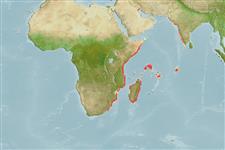Environment: milieu / climate zone / depth range / distribution range
Οικολογία
Θαλασσινό(ά) βενθικό(ς). Subtropical
Western Indian Ocean: Port Amelia, Mozambique to Natal, South Africa. Reported as likely at Seychelles (Ref. 1623) but Randall and van Egmond 1994 (Ref. 10685) believe otherwise.
Μέγεθος / Βάρος / Age
Maturity: Lm ? range ? - ? cm
Max length : 8.5 cm TL αρσενικό/απροσδιόριστο; (Ref. 5498)
Short description
Κλείδες προσδιορισμού | Μορφολογία | Μορφομετρία
Ραχιαίες άκανθες (συνολικά) : 14 - 16; Μαλακές ραχιαίες ακτίνες (συνολικά) : 7 - 9; Εδρικές άκανθες: 2; Μαλακές εδρικές ακτίνες: 6 - 7. Light brown to nearly black in color.
Anterolateral glandular groove with venom gland (Ref. 57406).
Life cycle and mating behavior
Γεννητική Ωρίμανση | Αναπαραγωγή | Γεννοβολία | Αβγά | Γονιμότητα | Προνύμφες
Poss, S.G., 1986. Aploactinidae. p. 479-480. In M.M. Smith and P.C. Heemstra (eds.) Smiths' sea fishes. Springer-Verlag, Berlin. (Ref. 5498)
IUCN Red List Status (Ref. 130435: Version 2024-2)
Human uses
Εργαλεία
Special reports
Download XML
Διαδικτυακές πηγές
Estimates based on models
Preferred temperature (Ref.
123201): 24.5 - 27.6, mean 26.9 °C (based on 78 cells).
Phylogenetic diversity index (Ref.
82804): PD
50 = 0.7500 [Uniqueness, from 0.5 = low to 2.0 = high].
Bayesian length-weight: a=0.01122 (0.00514 - 0.02450), b=3.04 (2.87 - 3.21), in cm total length, based on all LWR estimates for this body shape (Ref.
93245).
Τροφικό Επίπεδο (Ref.
69278): 3.4 ±0.3 se; based on size and trophs of closest relatives
Fishing Vulnerability (Ref.
59153): Low vulnerability (10 of 100).
